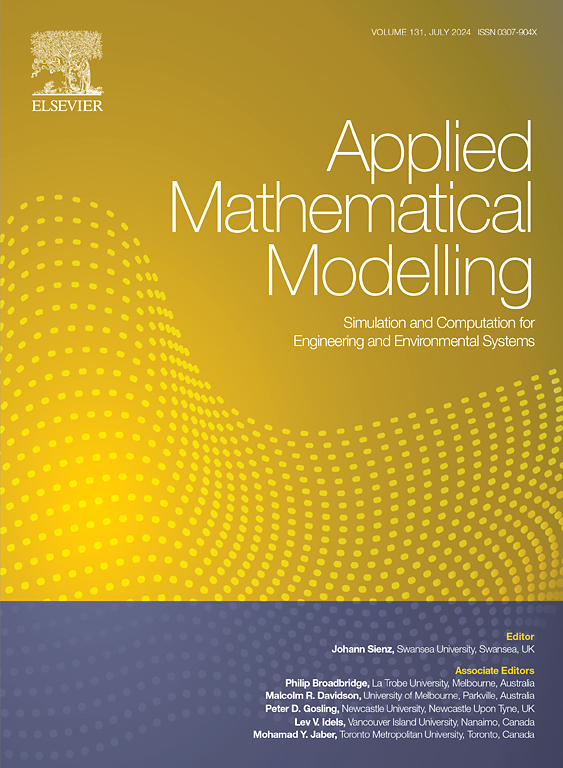Three-dimensional nonlinear vortex-induced vibrations of risers under internal gas-liquid and external shear flows
IF 4.4
2区 工程技术
Q1 ENGINEERING, MULTIDISCIPLINARY
引用次数: 0
Abstract
A novel three-dimensional (3D) dynamic model is proposed to explore the nonlinear vortex-induced vibration (VIV) characteristics of top-tension risers under the combined action of internal gas-liquid two-phase flow and external shear flow. The van der Pol equation is used to evaluate the interaction between the riser and the external shear flow. The nonlinear governing equations are established through Hamilton's principle, and they are discretized by the Galerkin method and solved via the Runge-Kutta method. The VIV responses calculated by the proposed nonlinear dynamic model are compared with the previously experimental and computational fluid dynamics (CFD) results, demonstrating the effectiveness and accuracy of the present theoretical method. The influences of the internal flow effect, the tension and the shear parameter of the external flow on the VIV responses of the riser are analyzed. The results show that when the internal flow effect is not considered, the transition of the external flow from uniform flow to shear flow leads to an increase in excited modes and a decrease in resonance responses of the riser in the cross-flow (CF) direction. Furthermore, with the increase of the external shear flow velocity, resonances at different positions of the riser are not synchronized, which is different from that of the riser in uniform flow. In the case of the riser conveying gas-liquid two-phase flow and being subjected to external uniform or shear flow, the increase in the velocity of the liquid phase leads to an increase in the maximum response amplitudes of the riser in the in-line (IL) and axial directions. When the internal flow changes from single-phase to gas-liquid two-phase, the maximum VIV responses of the riser in the IL and axial directions tend to decrease regardless of whether the riser is in uniform flow or shear flow.
内部气液流和外部剪切流下立管的三维非线性涡流诱导振动
本文提出了一种新型三维(3D)动力学模型,用于探索顶张立管在内部气液两相流和外部剪切流共同作用下的非线性涡致振动(VIV)特性。van der Pol 方程用于评估立管与外部剪切流之间的相互作用。通过汉密尔顿原理建立了非线性控制方程,并采用 Galerkin 方法对其进行离散化,通过 Runge-Kutta 方法对其进行求解。将所提出的非线性动力学模型计算出的 VIV 响应与之前的实验和计算流体动力学(CFD)结果进行了比较,证明了本理论方法的有效性和准确性。分析了内部流动效应、外部流动的张力和剪切参数对立管 VIV 响应的影响。结果表明,在不考虑内流效应的情况下,外部流体从均匀流向剪切流的过渡会导致激励模式的增加和立管在横流(CF)方向共振响应的减弱。此外,随着外部剪切流速度的增加,立管不同位置的共振不同步,这与匀速流下的立管不同。在立管输送气液两相流并受到外部均匀流或剪切流作用的情况下,液相流速的增加会导致立管在管内(IL)和轴向的最大响应振幅增加。当内部流动从单相流变为气液两相流时,无论立管处于匀速流还是剪切流中,立管在线性方向和轴向的最大 VIV 响应都趋于减小。
本文章由计算机程序翻译,如有差异,请以英文原文为准。
求助全文
约1分钟内获得全文
求助全文
来源期刊

Applied Mathematical Modelling
数学-工程:综合
CiteScore
9.80
自引率
8.00%
发文量
508
审稿时长
43 days
期刊介绍:
Applied Mathematical Modelling focuses on research related to the mathematical modelling of engineering and environmental processes, manufacturing, and industrial systems. A significant emerging area of research activity involves multiphysics processes, and contributions in this area are particularly encouraged.
This influential publication covers a wide spectrum of subjects including heat transfer, fluid mechanics, CFD, and transport phenomena; solid mechanics and mechanics of metals; electromagnets and MHD; reliability modelling and system optimization; finite volume, finite element, and boundary element procedures; modelling of inventory, industrial, manufacturing and logistics systems for viable decision making; civil engineering systems and structures; mineral and energy resources; relevant software engineering issues associated with CAD and CAE; and materials and metallurgical engineering.
Applied Mathematical Modelling is primarily interested in papers developing increased insights into real-world problems through novel mathematical modelling, novel applications or a combination of these. Papers employing existing numerical techniques must demonstrate sufficient novelty in the solution of practical problems. Papers on fuzzy logic in decision-making or purely financial mathematics are normally not considered. Research on fractional differential equations, bifurcation, and numerical methods needs to include practical examples. Population dynamics must solve realistic scenarios. Papers in the area of logistics and business modelling should demonstrate meaningful managerial insight. Submissions with no real-world application will not be considered.
 求助内容:
求助内容: 应助结果提醒方式:
应助结果提醒方式:


